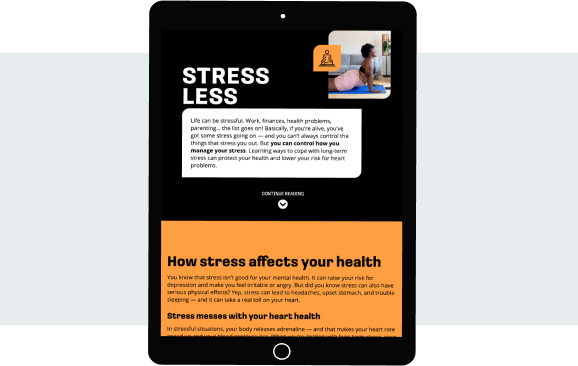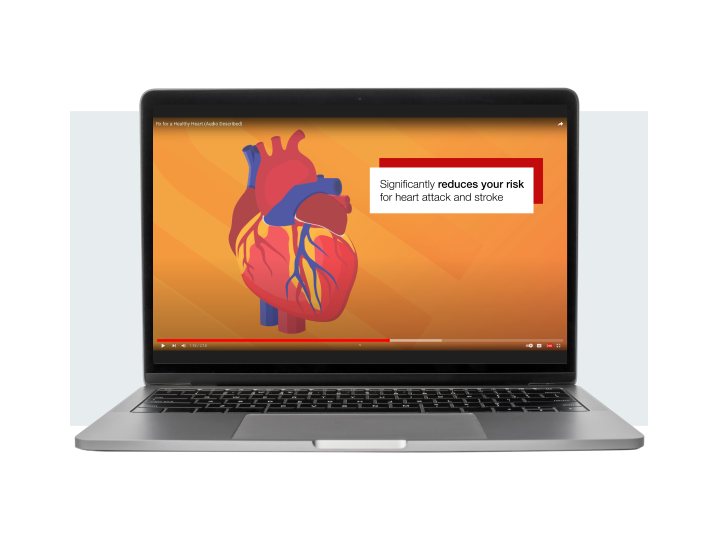Putting heart health first
CDC Foundation

Heart disease kills more people in the U.S. than any other disease. That’s why the Million Hearts® campaign, a national initiative co-led by the Centers for Disease Control and Prevention (CDC) and the Centers for Medicare & Medicaid Services (CMS), has an ambitious goal — to prevent 1 million heart attacks and strokes within 5 years.
In cooperation with the CDC Foundation (CDCF), we developed 2 consumer-focused assets to encourage heart-healthy habits and help people lower their risk of heart attack and stroke: the Live to the Beat campaign focused on Black and African American adults ages 35 to 54 — and the Heart-Healthy Steps website, tailored to adults ages 55 to 64 who are at risk of heart disease.
Our approach
As CDCF’s research and behavior change strategy partner, we supported our client every step of the way. We helped assess the campaign landscape, segment populations of need, and gain insight into the beliefs and motivations of the priority audiences. We made sure that the voice of the campaign aligned with our research findings — and we applied a behavior change lens and health communication best practices throughout the material development process.






Created web content designed to help reduce health disparities related to CVD in Black adults
We reviewed a national survey of 3,000 U.S. adults on what they know about cardiovascular disease (CVD). We learned that, compared with other groups, Black adults were least likely to say that they saw heart disease as preventable. And at the same time, we know that Black adults are twice as likely to die from heart disease as white adults. So we tailored the Live to the Beat website to Black adults ages 35 to 54. The site uses easy-to-understand language and a friendly, motivating tone. It highlights practical changes people can make — while acknowledging barriers that get in the way of making healthy choices. This way, we empowered the priority audience to take charge of their heart health by finding a rhythm — a beat! — that fits their unique needs and preferences.
Impact
We know there’s no one-size-fits all approach to heart health. So we designed materials that help get the right information about heart health to the right people, at the right time — in a style that works best for them. And that can save lives.

Developed an interactive tool to empower Black adults to take charge of their heart health
Pulse Check begins with a few questions about users’ motivations, preferences, and circumstances. Then, based on those answers, it delivers a tailored experience of health-focused modules that include a mix of interactive activities and questions, videos, and relevant health information. Pulse Check helps make sure that the information users are getting aligns with their needs and goals.

If you want to make a change in your life, there are a lot of different paths. We’re all unique, but we can all find something that works for us.”
— Research participant

Wrote actionable content to improve heart health for adults ages 55–65
By doing early research and concept testing with our priority audience, we learned what motivates them to adopt and maintain heart-healthy behaviors — and we learned what gets in their way. We used those insights to design content for the Heart-Healthy Steps website that answers people’s questions about heart disease and offers information in an empowering way.
Produced 8 engaging, animated videos to help people understand key concepts about CVD prevention
Each video expands on topics introduced on the Heart-Healthy Steps and Live to the Beat websites. They offer realistic actions people can take for good heart health, like moving more, avoiding “sneaky sodium”, and managing cholesterol levels. To make sure the videos reach as many people as possible, we also developed audio-described versions of each — adding narration to describe what’s happening on the screen, to be accessible for people who are blind or have low vision. And we kept the videos right around 1 minute in length, improving the chances that people watch them all the way through


